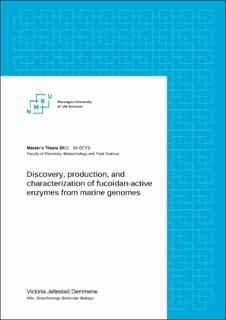| dc.description.abstract | Environmental challenges and decreasing amounts of fossil reserves make it challenging to meet the resource- and energy requirements of a growing world population. Biomass, with its organic material and carbon neutral qualities, can be used as a sustainable resource to substitute fossil resources. Until recently, terrestrial biomass has dominated sustainable biorefinery approaches, but marine biomass has several beneficial properties compared to terrestrial biomass. Seaweeds have a high carbohydrate content, and brown seaweeds particularly have great potential for sustainable marine biomass production where its polysaccharides can be utilized to produce fuels, chemicals, feed, food, and bioactive compounds. Extracting the different compounds in seaweed while preserving their structure is a big challenge, and the complete utilization of all the different compounds in seaweed is still not a reality. Fucoidan is a highly sulfated polysaccharide found in brown seaweeds that has recently gained much attention for being associated with biological and immunological properties, but the carbohydrate is highly unexplored and not well understood.
In this study, a marine metagenome was screened for protein sequences with the goal of identifying new fucoidan active enzymes that could be used to study and modify fucoidans. Through cloning, transformation, production, and activity testing of nine putative fucoidan active enzymes, the novel sulfatase AMOR_S25 was discovered. The sulfatase was active on fucoidans from Macrocystis pyrifera and enzymatic hydrolysates of fucoidan from Fucus vesiculosus, as well as on the artificial substrate p-nitrophenol sulfate (pNPS). Reactions with AMOR_S25 and pNPS allowed for quantitative analyses of sulfate release, which was used for enzyme characterization. AMOR_S25 was revealed to be very stable and has optimal activity at 40 °C and pH 6.5. Highest enzyme activity was achieved using 5 mM calcium and 150 mM sodium chloride. Kinetics analyses revealed a KM value of 16.2 mM and Vmax at 0.32 μM/min on the pNPS substrate.
Putative fucoidan enzymes were also sourced from the Lentimonas sp. genome, where the enzyme FunA_50 was produced and shown to have activity on fucoidan from F. vesiculosus. Characterization of FunA_50 was done by quantifying reducing ends produced during degradation of the substrate, and the enzyme was found to be most active at 40 °C and pH 8.0. Further characterization of FunA_50 is ongoing.
Although further studies will be necessary to fully understand these novel enzymes in terms of structure, specificity and mode of action, the discovery and characterization of AMOR_S25 and FunA_50 will contribute to increase the understanding of fucoidans and fucoidan specific enzymes and possibly practical applications of fucoidan. | |
